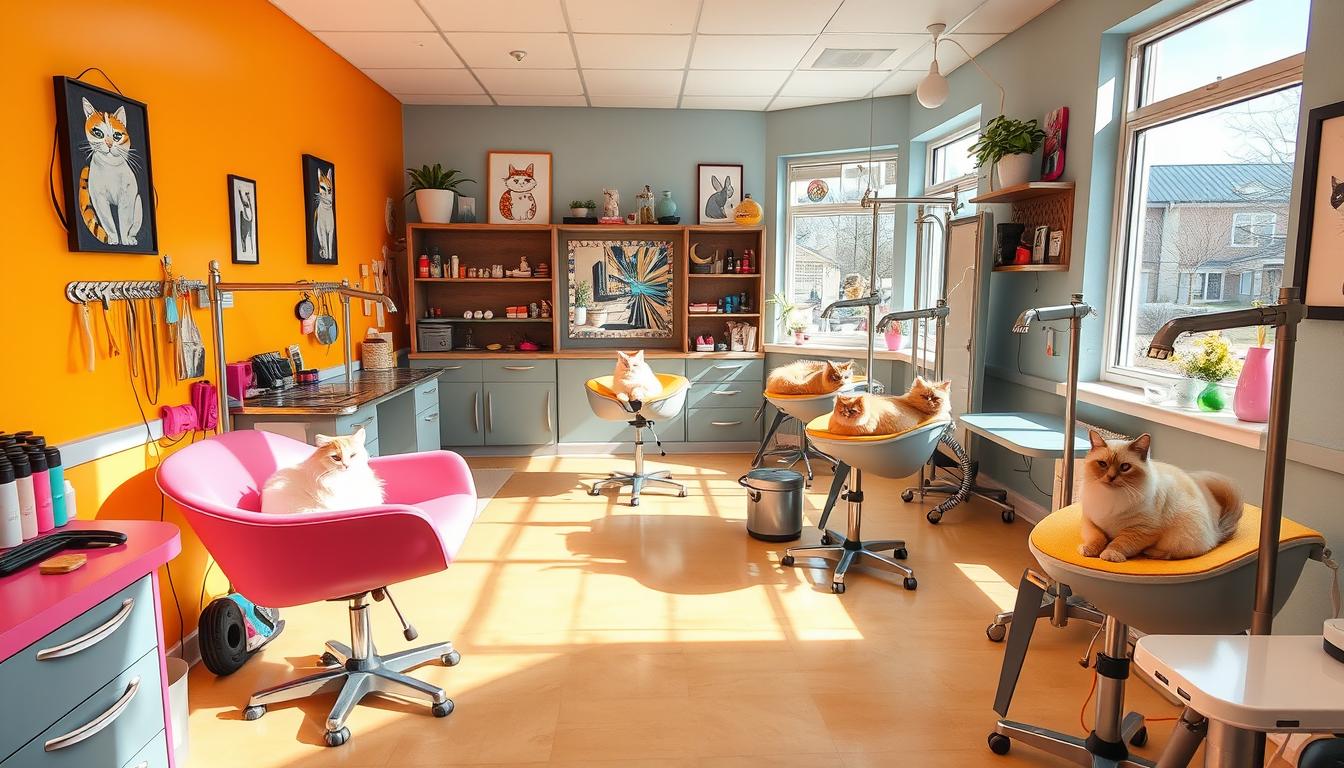Cat Years to Human Years: How Old Is Your Pet Really

Cat Years to Human Years: How Old Is Your Pet Really
Have you ever thought about how old your cat is in human years? Knowing how cats age can help you understand their health and needs better. We’ll explore how to figure out your cat’s age in human years.
Cats grow up fast, especially in their first two years. The first year is like 15 human years, and the second is like 241. After that, they age about four human years for each cat year1. This helps you know what your cat needs as they get older.
Cats usually live between 12 to 15 years. Purebreds live about 12.5 years, and crossbreds live about 14 years1. But, indoor cats can live up to 20 years or more2. Outdoor cats live about 13-14 years on average2. Things like breed, lifestyle, and vet care can affect how long a cat lives.
Key Takeaways
- Cats age rapidly in their first two years, with the first year equating to 15 human years and the second to 24 human years.
- After the first two years, cats age about four human years for each additional cat year.
- The average lifespan of cats is 12 to 15 years, with purebreds living around 12.5 years and crossbreds around 14 years.
- Indoor cats can live up to 20 years or more, while outdoor cats have a shorter average lifespan of 13-14 years.
- Breed, lifestyle, and veterinary care can all impact a cat’s longevity.
Understanding Cat Age Conversion Basics
Feline age conversion is key to caring for your cat. Cats go through life stages, each with its own needs. Learning about the cat aging process helps you meet your pet’s needs at each stage3.
The Science Behind Feline Aging
The cat-to-human age conversion isn’t just 1:7. Cats grow fast in their first year, like 15 human years45. After that, they age slower, adding about 4 human years for each year4.
Why Age Conversion Matters for Cat Care
Knowing your cat’s age in human years is crucial. As cats grow from kitten to senior, their needs change. Understanding these stages helps tailor your cat’s care to their age5.
Key Factors in Cat Age Development
Several factors help estimate a cat’s age, like dental health and coat condition. Watching these signs helps you adjust your cat’s care4.
| Cat Age | Human Equivalent |
|---|---|
| 1 year | 15 years |
| 2 years | 24 years |
| 3 years | 28 years |
| 4 years | 32 years |
| 5 years | 36 years |
| 6 years | 40 years |
| 7 years | 44 years |
| 8 years | 48 years |
| 9 years | 52 years |
| 10 years | 56 years |
“Tailoring care to match the cat’s human equivalent age helps in planning effective health strategies for their well-being.”5
Understanding cat age conversion, cat aging process, and feline age correspondence supports your cat’s needs. It ensures they get the right care for their life stage.
Cat Years to Human Years: The Accurate Calculation Method
Knowing how to convert cat years to human years is key for caring for your cat. It’s not just a simple math problem. In a cat’s first year, they reach the equivalent of 15 human years.67 By the second year, they’re like a 24-year-old human.7 After that, each cat year is about four human years7.
This method helps you understand your cat’s life stage. The conversion of cat years to human years varies based on the cat’s age on the chart, with age landmarks provided up to 25 years old in human equivalent.6 Knowing your cat’s age in human years helps you watch their growth. It lets you plan for their health needs and give them the right care.
“The accurate calculation method for converting cat years to human years is not a simple multiplication.”
Understanding how cats age helps you make better choices for their diet, exercise, and vet visits. This knowledge is crucial for any cat, from kitten to senior. It ensures your cat gets the best care at every stage of their life67.
The First Year: Rapid Development in Cats
The first year of a cat’s life is full of fast changes. Kittens grow fast, like humans in their teens8. They start with baby teeth at 3-4 weeks and get a full set by 6-7 weeks. Then, they start losing them around 3 months. By 6-7 months, they have 30 adult teeth8.
Physical Changes in Kitten Development
Kittens change a lot as they grow8. They become young adults at one year, finishing their growth and waiting to mature mentally8. The first year is like 15 human years. By age two, they are like 25 human years8. After that, each cat year is about four human years8.
Behavioral Milestones in Year One
Kittens show big changes in their first year9. Things like breed, genetics, and health affect how they age9. Knowing their age in human years helps with their diet, exercise, and health care. This helps with issues like joint problems or dental concerns9.
Enjoy every moment with your cat. Each stage, from kitten to senior, has its own special magic9.
| Cat Age | Equivalent Human Age |
|---|---|
| 1 year | 15 years |
| 2 years | 25 years |
| 3 years | 29 years |
| 4 years | 33 years |
| 5 years | 37 years |
| 20 years | 97 years |
“Cherishing every moment with your feline companion is emphasized, as each stage of a cat’s life, from playful kittens to wise senior cats, offers its unique magic.”
Average Life Expectancy of Indoor vs Outdoor Cats
Indoor cats live longer than outdoor cats. Indoor cats can live up to 16 to 18 years, and some even reach 20 years or more.10 Outdoor cats, however, have a much shorter life span of 13-14 years11.
Outdoor cats face many dangers. They can get hit by cars, catch diseases, and be attacked by other animals or cats11. A study by Jeff Horn found that diseases and other cats are the top causes of death for outdoor cats10.
Outdoor cats also travel far, covering about 12-16 backyards in their neighborhood10. This means they face more threats and cost more for vet care10.
Indoor cats, on the other hand, live safer and healthier lives. They get regular vet care, eat well, and have fun indoors11. Spayed or neutered indoor cats can live up to twice as long as outdoor cats12.
Choosing where your cat lives affects their health and life span. Keeping them indoors is safer and can make them happier and healthier for longer12.
“Transitioning outdoor cats to live indoors can significantly increase their life expectancy and keep them safe from outdoor hazards.”12
Determining Your Cat’s Age Through Physical Signs
As cats get older, they change in many ways. These changes help vets guess a cat’s age. This gives owners a better idea of their cat’s life stage13.
Dental Indicators of Age
Looking at a cat’s teeth is a key way to guess their age. Kittens start with baby teeth, which are replaced by adult teeth around 6 months14. Older cats may have tartar and worn, discolored teeth, showing their age13.
Coat and Muscle Condition Assessment
A cat’s coat and muscles also tell their age. Young cats have soft, shiny fur and strong muscles. As they age, their fur gets dull and their muscles weaken, especially in older cats14.
Eye Changes Throughout Aging
Eye changes are another sign of a cat’s age. Kittens have bright, clear eyes. Older cats may have cloudy lenses and other eye problems13. These changes help vets figure out a cat’s age14.
By watching these signs, owners and vets can understand a cat’s age. This helps them give the right care as cats grow older1314.
Breed-Specific Differences in Aging
Cats age at similar rates, but some breeds live longer. Siamese and Manx cats are known for their long lives15. Yet, a cat’s lifespan also depends on care, genetics, and environment16.
A cat’s health greatly affects their age and life span15. Healthy cats of the same size age less variably than dogs15. Knowing a cat’s life stage helps vets give the right care for their golden years15.
Mixed or crossbred cats often live longer than purebreds16. Some cats can live into their 30s with the right care and diet16. Learning about breed traits and lifespan factors helps ensure your cat lives a long, happy life with you.
“Caring for a cat is a responsibility that should not be taken lightly. Understanding the unique needs and lifespan of different breeds can help pet owners provide the best possible care for their feline friends.”
Health Considerations for Different Life Stages
As your cat grows older, their health needs change. Knowing the cat health stages and feline life stage care is key. It helps you support your pet at every stage of their life.
Young Adult Cat Care
Young adult cats, aged 1-6 years, need regular check-ups and preventive care. This includes vaccinations, parasite control, and dental cleanings. These steps keep them healthy and happy17. They might face issues like infectious diseases, dental problems, and heart disease18.
Senior Cat Health Management
Senior cats, around 11 years old (like 60 human years)18, need special care. Senior cat care includes more vet visits, special diets, and managing age-related issues. These include arthritis, diabetes, and kidney disease18. Regular vet visits are crucial to catch and treat these problems early.
| Feline Life Stage | Approximate Human Equivalent | Common Health Concerns |
|---|---|---|
| Kitten (Birth to 1 Year) | 0-15 Years | Infectious diseases, dental problems, cystitis, intestinal issues, heart disease |
| Young Adult (1-6 Years) | 15-40 Years | Infectious diseases, dental problems, cystitis, intestinal issues, heart disease |
| Mature Adult (7-10 Years) | 44-60 Years | Constipation, diabetes, high blood pressure, hyperthyroidism, kidney disease |
| Senior (Over 10 Years) | 60+ Years | Arthritis, diabetes, high blood pressure, hyperthyroidism, kidney disease |
Regular vet visits and proactive care are vital for your cat’s health. Understanding each cat health stage ensures your cat gets the best care. This way, you can help your cat live a long and happy life.
“Proper care and attention to your cat’s evolving health needs can make a significant difference in their quality of life and lifespan.”
Impact of Lifestyle on Cat Aging
Your cat’s lifestyle choices can greatly affect their aging process19. Things like diet, exercise, and stress levels are key. Indoor cats may live longer but need mental and physical stimulation to stay healthy.
As cats get older, their needs change19. They may face health issues like weakened immune systems and dehydration. It’s important to keep them hydrated and active to support their health.
Dental health is also vital for aging cats.19 Older cats often get dental disease, which can hurt their ability to eat. Regular vet visits help catch and treat these problems early.
Breed-specific differences can also affect your cat’s needs20. Knowing your cat’s breed can help you tailor their care. Making small changes to their environment and activities can greatly improve their life.
Creating a caring, stimulating, and stress-free environment is key20. Regular vet visits, a balanced diet, and an active lifestyle are essential. By understanding how to support your cat’s aging, you can help them live a long, happy life.
Modern Veterinary Science and Cat Longevity
Advances in cat veterinary advancements have greatly helped cats live longer. Better food, understanding cat health technology, and new treatments have all helped. These changes have made cats’ lives better and longer21.
Regular vet visits, preventive care, and catching health problems early are key. Knowing how old our cats are in human years helps us care for them better. This way, they can live long, happy, and healthy lives222123.
New tools and treatments have changed how we care for cats. From new imaging to special therapies, modern cat veterinary advancements have improved care. This has led to better feline longevity improvements2221.
Using these cat health technology advancements and keeping an eye on our cats’ health is important. This way, they can stay healthy and happy for a long time. This approach not only makes them live longer but also makes their lives better. It lets us enjoy every moment with our pets2123.
“The key to a cat’s longevity lies in the synergy between cutting-edge veterinary science and dedicated pet parents who prioritize their feline’s health and well-being.”
Supporting Your Cat Through Different Life Stages
As your cat gets older, their needs change. Cat life stage support and feline age-appropriate care are key to keeping them healthy. Knowing what each stage needs helps your cat stay happy and healthy.
Kittens need lots of play, socialization, and the right food. Young adult cats need a balanced diet, exercise, and dental care. Senior cats need help with age-related issues like arthritis and vision loss.
Regular vet visits are important at every stage. Your vet can spot health issues early and suggest the best care. Watching for changes in your cat’s behavior and health is also important.
Changing your cat’s care as they age helps them live well. By focusing on cat life stage support and cat aging assistance, your cat can enjoy their later years fully.
| Life Stage | Key Considerations |
|---|---|
| Kitten | Proper nutrition, playtime, socialization |
| Young Adult | Balanced diet, regular exercise, dental health |
| Senior | Managing age-related conditions, veterinary care |
“Caring for a cat at different life stages is a beautiful journey that requires adapting to their evolving needs. With the right feline age-appropriate care, we can ensure our cats enjoy their golden years to the fullest.”
Conclusion
Learning about cat years and human years helps you care for your feline friends better25. It shows how cats grow fast in their youth and change slowly as they age25. This knowledge lets you meet their needs, adjust their care, and keep them happy and healthy25.
Things like genetics, diet, and lifestyle affect a cat’s life and health25. So, it’s key to tailor your care to fit your cat’s unique needs25.
Knowing about feline life stages strengthens your bond with your cat25. It helps you give them the best care at every stage of their life25. By watching for changes, keeping up with vet visits, and enriching their environment, you can help them live a long and happy life25.
Understanding cat years helps you be a better cat owner25. It lets you make smart choices, meet their needs, and grow closer to your cat25. By using this knowledge, you can give your cat the best life possible25.
FAQ
How do I convert my cat’s age to human years?
Cats grow fast in their first two years. The first year is like 15 human years, and the second is like 24. After that, they age about four human years for each cat year.
Why is understanding a cat’s age in human years important?
Knowing a cat’s age in human years helps owners give the right care. It helps predict health issues and keep their cat happy and healthy for life.
What are the key factors in determining a cat’s age?
Fast growth in the first year is key. Then, aging slows down. Teeth, coat, muscle, and eyes show a cat’s age.
How do indoor and outdoor cats differ in lifespan?
Indoor cats live longer, up to 20 years. Outdoor cats live about 13-14 years due to dangers outside.
Are there breed-specific differences in cat aging?
Most cats age the same, but some breeds live longer. Siamese and Manx cats live the longest. But, care, genetics, and environment also matter.
What are the health considerations for different life stages in cats?
Young cats need regular check-ups. Senior cats, over 11 years, need more vet visits and special diets. They also need help with arthritis and dental problems.
How does a cat’s lifestyle impact its aging process?
Diet, exercise, and mental stimulation affect aging. Indoor cats live longer but need mental and physical activities to stay healthy.
How have advancements in veterinary science contributed to increased cat longevity?
Better nutrition and health understanding have helped cats live longer. Regular vet visits and early health checks are crucial for a long, happy life.



